The Gopher protocol is a communication protocol designed for distributing, searching, and retrieving documents in Internet Protocol networks. The design of the Gopher protocol and user interface is menu-driven, and presented an alternative to the World Wide Web in its early stages, but ultimately fell into disfavor, yielding to HTTP. The Gopher ecosystem is often regarded as the effective predecessor of the World Wide Web.
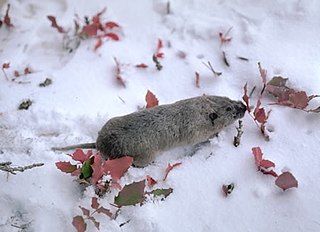
The northern pocket gopher is a small gopher species native to the western United States and the Canadian provinces of Alberta, Saskatchewan, British Columbia, and Manitoba.
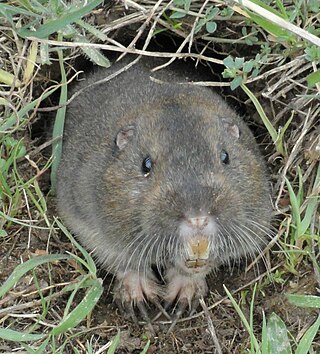
Pocket gophers, commonly referred to simply as gophers, are burrowing rodents of the family Geomyidae. The roughly 41 species are all endemic to North and Central America. They are commonly known for their extensive tunneling activities and their ability to destroy farms and gardens.

The smooth-toothed pocket gophers, genus Thomomys, are so called because they are among the only pocket gophers without grooves on their incisors. They are also called the western pocket gophers because they are distributed in western North America. They are considered distinct enough from other pocket gophers to be recognized as a separate subfamily or tribe.

The Mazama pocket gopher is a smooth-toothed pocket gopher restricted to the Pacific Northwest. The herbivorous species ranges from coastal Washington, through Oregon, and into north-central California. Four subspecies of the Mazama Pocket Gopher are classified as threatened under the Endangered Species Act of 1973, including T. m. pugetensis, T. m. tumuli , T. m. glacialis, and T. m. yelmensis. The Mazama Pocket Gopher is one of the smallest of 35 species in the pocket gopher family.

Botta's pocket gopher is a pocket gopher native to western North America. It is also known in some areas as valley pocket gopher, particularly in California. Both the specific and common names of this species honor Paul-Émile Botta, a naturalist and archaeologist who collected mammals in California in 1827 and 1828.
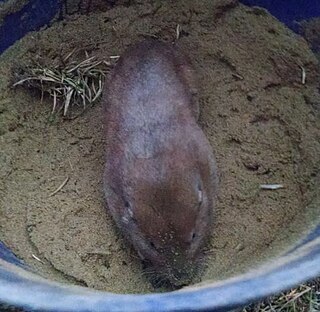
The southeastern pocket gopher is a species of pocket gopher that is native to the southeastern United States. It occurs in Alabama, Georgia, and Florida, where it is the only pocket gopher.
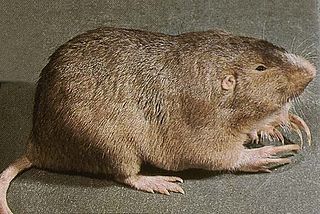
The plains pocket gopher is one of 35 species of pocket gophers, so named in reference to their externally located, fur-lined cheek pouches. They are burrowing animals, found in grasslands and agricultural land across the Great Plains of North America, from Manitoba to Texas. Pocket gophers are the most highly fossorial rodents found in North America.
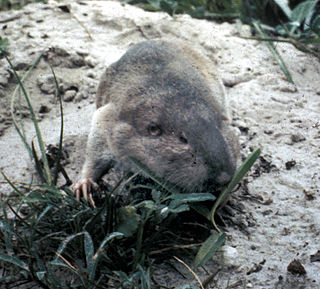
The Texas pocket gopher is a species of rodent in the family Geomyidae. It is found in Tamaulipas in Mexico and in Texas in the United States.
The tropical pocket gopher is a species of rodent in the family Geomyidae. It is endemic to Mexico. Its natural habitat is hot deserts. It is threatened by habitat loss.
Heterogeomys is a genus of rodent in the family Geomyidae, found in Mexico, Central America and Colombia. Heterogeomys are a small genus of rodents commonly known as pocket gophers, though the term applies to all genera within the family Geomyidae. The name pocket gopher was earned for this family because of their fur lined cheek pouches that can be used for carrying food. These pouches can also be turned inside out. Species of Heterogeomys are regarded as pests, one of less than 5% of rodent species classified as pests, and the history of man's attempts to control their populations reaches back into Mayan times. Despite some efforts to the contrary, populations of Heterogeomys seem to be on a general upwards trend. Furthermore, all of the species of Heterogeomys are considered to be of Least Concern in the World Status Key.

The camas pocket gopher, also known as the camas rat or Willamette Valley gopher, is a rodent, the largest member in the genus Thomomys, of the family Geomyidae. First described in 1829, it is endemic to the Willamette Valley of northwestern Oregon in the United States. The herbivorous gopher forages for vegetable and plant matter, which it collects in large, fur-lined, external cheek pouches. Surplus food is hoarded in an extensive system of tunnels. The dull-brown-to-lead-gray coat changes color and texture over the year. The mammal's characteristically large, protuberant incisors are well adapted for use in tunnel construction, particularly in the hard clay soils of the Willamette Valley. The gophers make chattering sounds with their teeth; males and females make purring sounds when they are together, and the young make twittering sounds. Born toothless, blind and hairless, the young grow rapidly before being weaned at about six weeks of age.

The Wyoming pocket gopher is a species of gopher that is endemic to the United States. Between 1915 and 1979, it was generally considered to be a subspecies of the northern pocket gopher.

The mountain pocket gopher is a species of rodent in the family Geomyidae. It is endemic to California and Nevada. The Sierra Nevada are part of its range.

Townsend's pocket gopher is a species of pocket gopher endemic to the northwestern United States.

The southern pocket gopher is a species of rodent in the family Geomyidae. It is found in Mexico and the United States, usually in high altitude grassland and shrubland. It feeds on plant material and has an extensive burrow above which is a large heap of earth on the surface of the ground.
The Michoacan pocket gopher is a species of rodent in the family Geomyidae. It is monotypic within the genus Zygogeomys. It is endemic to Mexico where its natural habitat is temperate, high-altitude forests. Its numbers are declining and it is listed by the IUCN as "endangered".
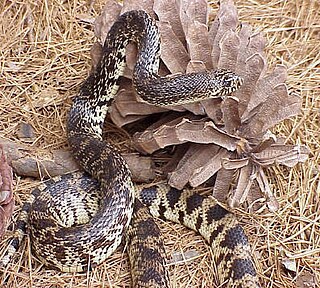
The Louisiana pine snake is a species of large, non-venomous, constrictor in the family Colubridae. This powerful snake is notable because of its large eggs and small clutch sizes. The Louisiana pine snake is indigenous to west-central Louisiana and East Texas, where it relies strongly on Baird's pocket gophers for its burrow system and as a food source. The Louisiana pine snake is rarely seen in the wild, and is considered to be one of the rarest snakes in North America. The demise of the species is due to its low fecundity coupled with the extensive loss of suitable habitat - the longleaf pine savannas in the Gulf coastal plain of the southeastern United States. Management activities are being conducted to promote the species' recovery.

Baird's pocket gopher or the Louisiana pocket gopher is a species of pocket gopher that is native to the southern United States. In total, there are three almost identical species of eastern pocket gopher; Geomys attwateri, G. bursarius, and G. breviceps. G. breviceps is larger in size, G. attwateri is medium-sized and G. bursarius is a bit smaller. Other than by size variation they are not identifiable by external features. Baird's pocket gophers are small rodents with most of their weight on the top half of their bodies.














